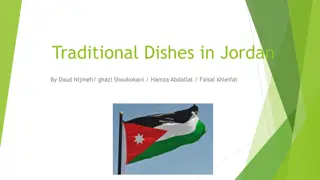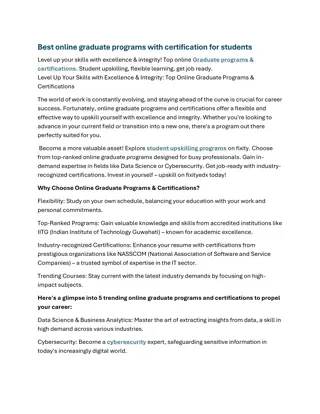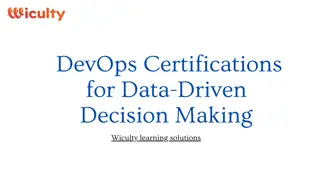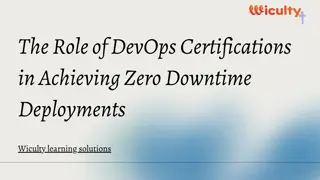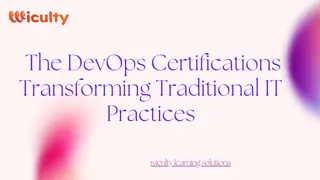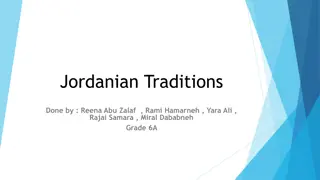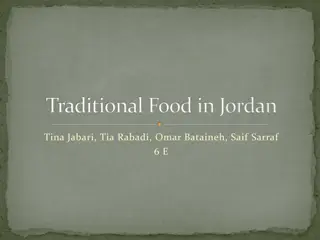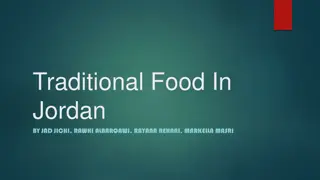Standards and Certifications in the Jordanian Food Sector
This presentation sheds light on the standards and certifications applicable in the Jordanian food sector, emphasizing the importance of both mandatory and voluntary regulations. It discusses the significance of adhering to quality and safety standards, biodiversity protection, and efficient resource usage. The document also explores the potential for tapping into new markets by aligning with sustainable certification demands, particularly focusing on opportunities beyond traditional export destinations like Saudi Arabia and Iraq.
Download Presentation

Please find below an Image/Link to download the presentation.
The content on the website is provided AS IS for your information and personal use only. It may not be sold, licensed, or shared on other websites without obtaining consent from the author.If you encounter any issues during the download, it is possible that the publisher has removed the file from their server.
You are allowed to download the files provided on this website for personal or commercial use, subject to the condition that they are used lawfully. All files are the property of their respective owners.
The content on the website is provided AS IS for your information and personal use only. It may not be sold, licensed, or shared on other websites without obtaining consent from the author.
E N D
Presentation Transcript
1 Knowledge Product 2 Knowledge Product 2 Standards and Standards and Certificates in the Certificates in the Jordanian Food Jordanian Food Sector Sector
2 Published by the Deutsche Gesellschaft f r Internationale Zusammenarbeit (GIZ) GmbH Registered offices Bonn and Eschborn, Germany Trade for Employment (T4E) Project GIZ Jordan Mohamed Baseem Al-Khammash St. 13, Sweifeh Amman 11190 Phone +962-6-5868090 giz-jordanien@giz.de https://www.giz.de/en/worldwide/121977.html Jordan Exports 156 AlMadina AlMonawara St. Masaken Building, Office #505, Amman JORDAN Phone +962 6 5777710 info@jordanexports.jo https://jordanexports.jo As at December 2023 Design and Text adelphi consult GmbH: Mirko Zuerker, Paula Cros Marchena, Eduardo Austin, Irina Kireeva On behalf of the German Federal Ministry for Economic Cooperation and Development (BMZ) and and the Kingdom of the Netherlands.
3 Contents 1 Standards and Certifications in the Jordanian Food Sector 2 Step-by-Step Guidance for Standards and Certifications 3 Support for Standards and Certification in Jordan
4 Standards and Certifications in the Jordanian Context Guide the processing of food and agricultural and trade practices to address several sustainability issues: Can be of voluntary or mandatory nature: Mandatory requirements/regulations Stem usually from governmental regulations (part of the legal framework technical regulations), setting standards for products and production methods to be required both for national production and imported products. Cover food safety (to protect the health of consumers - e.g. maximum pesticide residue limits-), labelling schemes (e.g. traffic light approach for processed food), and minimum environmental requirements. Include mandatory due diligence to enhance transparency and accountability of business operations regarding human rights and environmental protection in their supply chain. Quality and safety of products Protection of biodiversity Maintaining the health of soil and ecosystems Efficient use of resources (e.g. water and energy) Voluntary standards Mitigating climate change Usually set by non-governmental organisations, industry associations, NGOs, etc., but also public regulators like the EU. Go beyond mandatory regulations including environmental, social, and ethical voluntary guidelines with the purpose of making visible a company s commitment to good practices in the social, environmental and ethical sphere. Often involve stricter requirements and certification protocols. Social and ethical topics (working conditions, human rights, sustainable social development) Quality of management systems for compliance
5 Standards and Certifications in the Jordanian Context As the demand for food products with sustainable certification grows, fresh opportunities to tap into new markets arise. Moving beyond existing markets and leveraging growth opportunities Jordan s main export partners for food products are Saudi Arabia, Iraq, Qatar, United Arab Emirates, and Occ. Pal. Terr. These have a Muslim-majority population, resulting in the Halal certification being widely used. Among those main export markets, green standards are typically not yet valued highly by customers Hence, great opportunities lie with tapping into newer markets for food products (e.g. EU and USA), where the demand for green certifications is growing rapidly. Furthermore, to comply with regulations and the high levels of inspection on food safety worldwide, certifications related to food safety are also being widely adopted. What does this mean? Awareness and demand of green certifications by consumers is increasing, and although in some regions or countries it is more prevalent than others, the trend applies for all. In some cases, these green standards can become mandatory (e.g. through the European Due Diligence Act, which will require suppliers to comply with stricter transparency requirements), and thus food companies will need to get certified. Buyer s demand is setting the benchmark for standard use and certification in Jordan. When there is a need from a market or potential market, companies interest in getting certified increases. Proactively seeking green certifications may grant significant advantages to food companies to access these new markets.
6 Arar Farms: Jordanian certified company Location: Farm at the Jordan Valley, Office in Amman What they do: Production and commercialisation of Medjoul and Barhi dates, seedless grapes, asparagus, citrus Resulting in Recognition and Market Expansion Opportunities Certified 1. Increasing exports: 50% of production of Medjool dates and 25% of Barhi dates is exported Best Practices and Research on The Benefits Harvesting and Postharvest Handling of Dates Staying on top of new technologies and innovations to increase quality requirements by customers Export markets include: Eastern Europe, Gulf countries, Turkey, Indonesia and France. Indian red palm weevil Post-harvest Dates Operations 2. Support and promotion Water scarcity in Jordan and how to minimise the negative effects by international and national organisations and at international events Wastewater uses Harvesting and Postharvest Handling of Dates
7 Tamara Farms: Jordanian certified company Location: South Jordan, at the Jordan Valley What they do: Production and commercialisation of healthy royal Medjoul dates Resulting in Awards and Recognition Certified The Benefits The Practices Improved date palm productivity Propagation and crop management Improved use of water Biotechnology and germplasm conservation Ensure great quality for customers Crop protection and integrated Pest Management (IPM) First Place First and Second Place Jordan International Date Palm Festival in 2028 and 2019 Higher shelf life Cleansing Cairo Dates Festival 2021 - Best semi-dry dates Post-harvest handling and processing techniques Storing
8 What exactly are standards? Standards vs. Certification Process by which a third-party entity assesses and verifies that an organisation, product, service, or process complies with a specific standard Conducted by accredited bodies Results in a certification, adherence to the standard Provides external validation to stakeholders Demonstrates commitment to meeting established criteria Set of guidelines, criteria, or specifications that define minimum requirements for a product, service, or process Ensures consistency, quality, safety, and interoperability Can be developed by standardisation bodies, industry associations, or regulatory agencies Often voluntary; organizations can choose whether or not to adopt them certification Standard Certification indicating Example: In the context of food safety, a standard might outline the best practices, processes, and conditions that food producers should adhere to in order to ensure the safety and quality of their products The food producer might seek certification to demonstrate that their processes align with the particular food safety standard
9 The role of voluntary standards The rise of voluntary standards. The increase in ecological consciousness and the fast advancements in agriculture, brought the rapid development of grassroots organic and fair trade movements. Alongside globalisation, sustainability initiatives also became more popular, motivating enterprises to develop Corporate Social Responsibility (CSR) strategies to protect their reputations. Voluntary standards then made it possible to verify and certify the firms responsible business conduct. Today, motivated mainly by consumer demands and public incentives, the number of certified companies and/or products continues to increase. Voluntary standards play a crucial role in responding to the increasing demand for sustainable and ethically produced agricultural and food products for several reasons: Consumer Trust and Confidence Environmental Stewardship Access to Premium Markets Market Differentiation Social Responsibility Demonstrate social responsibility by addressing concerns about labour conditions and community well-being Many consumers are willing to pay a premium for products that align with their values, providing economic incentives for producers Contributing to the conservation of natural resources, reduction of environmental impact, and overall sustainability in agriculture Providing a transparent framework for the production process fosters trust among consumers Labels become valuable marketing tools, allowing producers to distinguish their products in the market Global Trade Opportunities Innovation and Continuous Improvement Collaboration and Stakeholder Engagement Legal Dimension / Regulatory Compliance Risk Mitigation Providing a common language and set of expectations eases access to international markets and meeting the consumers diverse requirements and preferences Collaboration between industry stakeholders, NGOs, and consumers, fosters shared responsibility and allows for diverse perspectives to be considered Serving as a precursor or complement to regulatory frameworks, makes it easier to comply with potential future regulations, staying ahead of evolving legal requirements Promoting the adoption of new technologies and practices that enhance sustainability encourages innovation Preventing negative publicity and legal challenges, safeguarding the reputation of agricultural businesses
10 The role of voluntary standards The nature of standards being voluntary to join but mandatory to comply with once agreed upon represents a specific approach to industry self-regulation. The voluntary-to-mandatory nature of standards combines the flexibility of voluntary adoption with the commitment to compliance, creating a mechanism for industry self-regulation that addresses specific challenges while allowing for adaptability and continuous improvement. Voluntary Adoption Commitment to Compliance Industry Self-Regulation Credibility and Trust Once an organisation decides to adopt a particular set of standards, it makes a commitment to comply with all the provisions outlined in those standards. This commitment is essential for the credibility and effectiveness of the standards. Rigorously following voluntary standards enhances the credibility and trustworthiness of organisations. This is particularly important in industries where consumer trust plays a crucial role, such as in the food and agriculture sectors. Organisations, whether they are in the agricultural, food production, or any other industry, can voluntarily adopt specific standards or guidelines. This allows flexibility and respects the autonomy of individual entities. Instead of waiting for external regulations imposed by government bodies, organisations proactively agree to adhere to a set of guidelines that address various aspects such as sustainability, ethics, or quality. Market Access and Differentiation Potential Sanctions for Non-Compliance Stakeholder Collaboration Adherence to voluntary standards can provide organisations with access to certain markets that prioritise or require compliance with specific criteria. The certification or labels become differentiators in the marketplace. While joining the standards is voluntary, non- compliance later may result in loss of certification, exclusion from certain markets, or damage to reputation, which can have economic and operational impacts. Collaboration between stakeholders (including industry representatives, NGOs, and government agencies) ensures that the standards are well-rounded and consider multiple perspectives.
11 What exactly are standards? Standards vs. Regulations Standards can be classified based on various criteria, including their scope (specific products such as coffee, sugar, etc., certain aspects of sustainability, and specific sectors), governance, e.g. private or public issuing body, for-profit or non-profit, etc.), and type of instrument (audit protocol, code of conduct, etc.). All mandatory legal food safety requirements are rooted in fundamental concepts like Hazard Analysis and Critical Control Points (HACCP) and Good Manufacturing Practices (GMP). Regulations & mandatory requirements Standards Systematic approach to identify, assess, and control hazards in food production. Emphasises preventive measures during the entire production process. Hazard Analysis and Critical Control Points (HACCP) For-Profit & Non- Profit De Facto Public Performance Sector-specific Product Sets the baseline for hygiene and manufacturing standards. Ensures the production of safe and quality food products. International & Regional Standards Good Manufacturing Practices (GMP) Management Private Process De Jure Sustainability / Green GMP's counterpart in the primary sector, focusing on agricultural practices. Emphasizes environmental and social responsibility in food production. Good Agricultural Practices (GAP) Benchmarking tools ESG rating programs Audit protocols Codes of conduct While GMP or GAP provides basic concepts, a risk analysis system addresses possibilities in the secondary product chain. Focuses on preventive measures to manage and mitigate risks. Risk Analysis in Secondary Product Chain e.g. FEFAC Soy Benchmarking tool e.g. Fair Labour Association Agriculture Code of Conduct e.g. Sustainalytics e.g. GLOBALG.A.P Crops Collaboration among leading food safety experts from retailers, manufacturers, and food service companies. Mission: Continuous improvement in food safety management systems. GFSI is not a certification program but sets benchmarking requirements. Programs meeting these requirements are "recognized" by GFSI. Recognition indicates competence and international acceptance after a demanding assessment. Reporting initiatives Guidance and good practices Global Food Safety Initiative (GFSI) Due diligence frameworks e.g. OECD-FAO Guidance for Responsible Agricultural Supply Chains e.g. Global Reporting Initiative e.g. SAFA-Sustainability Assessment of Food and Agriculture Systems
12 Relevant Food Safety Regulations and Frameworks Food safety regulations and frameworks vary across regions and countries, but beyond national regulatory authorities, there are organisations and common initiatives that aim at ensuring food safety globally: World Health Organisation (WHO) Hazard Analysis and Critical Control Points (HACCP) Provides guidelines on various aspects of food safety Codex Alimentarius Commission (Codex) International body established by WHO and FAO. It develops international food standards, guidelines, and codes of practice Each country has its own regulatory authority responsible for implementing and enforcing food safety and further regulations. Food and Agriculture Organization (FAO) National Regulatory Authorities Provides guidelines on various aspects of food safety E.g. countries majority explained before. Halal regulations with a population, in Global Food Safety Initiative (GFSI) Muslim- as Private industry-driven initiative that benchmarks and recognises food safety standards
13 Relevant European Food Safety Regulations and Frameworks The European food policy aims at protecting human health and consumer interests, and fostering the smooth operation of the European market. With that aim, the EU thus ensures that control standards are established and adhered to in the areas of feed and food-product hygiene, animal health, plant health, the prevention of food contamination from external substances, as well as labelling for food and feed products. The EU actively participates in the work of the international organisations presented in the previous page and aligns and incorporates international standards and frameworks into its own regulatory framework. The most relevant regulations are presented below. Lays down general principles and definitions for national and regional food law Applicable at all stages of food production, processing and distribution, including primary production Lays down procedures for matters with a direct or indirect impact on food and feed safety The Food Law Regulation (Reg. (EC) No 178/2002) Apply to food business operators Lays down hygiene requirements for all foodstuffs at all stages of production, processing and distribution Requires the application of HACCP in the production of foodstuffs The Hygiene Package Regulation (Reg. (EC) No 852/2004; No 853/2004; No 854/2004; No 882/2004) Aimed at supervisory authorities Lays down the responsibilities of the competent supervisory authorities at the national and European levels Regulation for official controls to be carried out to ensure compliance with high standards set The Control Regulation (Reg. (EU) No 2017/625)
14 Relevant European Food Safety Regulations and Frameworks Contains requirements for: improving legibility (e.g. minimum font size on prepacked foods), clear labelling of food imitations, improving allergen labelling on prepacked foods, obligatory labelling of allergens on non-prepacked foods and mandatory provisions governing nutritional labelling on foodstuffs The Food Information Regulation (Reg. (EC) No 1169/2011) Cover agricultural products, including aquaculture and yeast Encompass every stage of the production process, from seeds to the final processed food. Contain several regulations for production & labelling, controls, and trade: https://agriculture.ec.europa.eu/farming/organic-farming/legislation_en Organic food regulations Encompassed in the European Green Deal, aims to make food systems fair, healthy and environmentally friendly Proposes a legislative Framework for Sustainable Food Systems (FSFS) aiming to accelerate the transition to a sustainable food system that should: 1.Have a neutral or positive environmental impact 2.Help to mitigate climate change and adapt to its impacts 3.Reverse the loss of biodiversity 4.Ensure food security, nutrition, and public health, making sure that everyone has access to sufficient, safe, nutritious, sustainable food 5.Preserve affordability of food while generating fairer economic returns, fostering the competitiveness of the EU supply sector, and promoting fair trade. Will revise the EU rules on the food information provided to consumers to help them make healthier and more sustainable food choices and tackle food waste Farm-to-fork Strategy
15 Overview of Relevant Standards and Certifications in Jordan There is a vast amount of standards applicable and relevant to food companies in Jordan that go beyond mandatory requirements. Although in general, standard certification is sought most commonly by large companies*, food SMEs can equally benefit from obtaining certifications. The most relevant standards and certifications for food SMEs in Jordan are mapped in the following page. In the map, standards and certifications voluntary ( ) and mandatory ( )- are both shown. Although several standard categories were presented before, this map condenses and categorises them based on the focus topic and the level of difficulty to implement and obtain the certification. And, in the pages following the map, a factsheet is presented for each of the most relevant ones for food SMEs in Jordan, considering the level of effort, topics covered, as well as the relevance for current and potential export markets. At the end, you can also find available organisations that can support implementation and certification. * Currently, micro-enterprises generally do not implement standards or get certified. The most commonly implemented standards focus on food safety: HAACP, ISO22000 (for smaller companies) and FSSC (for bigger companies), and Halal certification, which is not required for the local market but for exporting, especially to Saudi Arabia. Aside from food safety, GlobalG.A.P and organic certifications are most common. Some certifications, such as Fairtrade, SMETA, ISO 14001 and BRCGS, are not usually pursued in Jordan, although there might exist accredited certification bodies in the country. Keep on reading the next pages to learn more about all the benefits that you can obtain by getting certified!
16 Overview of Relevant Standards and Certifications in Jordan Level of difficulty to implement beginner advanced intermediate Food Safety Focus of the standard Quality Environment Social & Ethics Overarching * Although there are overlaps between the focus topics of certificates, the mapping aims to provide the strong point of the certification. Likewise, the level of effort for implementation is not a strict absolute scale, and is represented in relative terms to other standards
Environ- mental Social & Ethics Over- arching 17 Safety Quality beginner level Halal (GSO- 2055) What is it? Quality assurance applied to foods, products and services that follow the Islamic Law. Granted by a Halal certification body, this certification guarantees that the products do not contain anything that is considered illegal by Islamic law and that these are prepared, processed, transported and stored avoiding any element prohibited by said law and guaranteeing that these have no contact with other (non-Halal) foods. It includes specific rules for production, slaughter and other quality standards set by Islamic Sharia. Mandatory implementation In target country if it is market with Islamic majority population High acceptance/use in international markets Recognized in countries with Islamic majority (Current Halal market: 1.9 billion Muslims. Worth over $1.27 trillion as of 2021) Medium relevance in the agri- food sector Food Quality (Religion-related) focus Estimated cost > $1500 (+ $1300 approx. if there is no food safety mgmt. system accreditation) Time estimated: Around 6 months Ease of implementation Issued by public body Certification of Product or site/farm: materials / ingredients Benefits for the company: International market entry: Export to countries with a Muslim-majority population huge market opportunity predicted to reach US$4.96 trillion by 2030. Increases your opportunity to grow your sales in other countries and markets with a need for Halal products. Increased trust from customers: those who see Halal logos on the products are likelier to trust and buy from your brand. Increased reputation and cost saving: Improve safety and quality, reducing risk of recalls and other reputation- damaging incidents, ultimately saving you money. Third-party verification by accredited certification body JSMO and private bodies Label/seal obtained: Halal certification and mark/seal to use in products Valid for 3 years, recertification needed after this time
Environ- mental Social & Ethics Over- arching beginner level 18 Safety Quality HACCP - Hazard analysis and critical control points What is it? Management system to ensure food safety. The system addresses three points: 1) identification and assessment of hazards associated with the food product, 2) determination of critical control points to regulate the identified hazards, and 3) establishment of a system to monitor the critical control points. This system is also one part of the ISO 22000 standard. Mandatory implementation In Jordan and target country Very high relevance in the agri- food sector Very high acceptance/use in international markets Food Safety focus Estimated cost Implementation from ~$25K to 54K Certification from ~$7K to 9K and Recertification from ~$4.5K Time estimated: Around 6 months Ease of implementation Issued by public body Certification of Production process and methods: management system Benefits for the company: Third-party verification by accredited certification body JSMO and private bodies Law compliance: Ensures you are compliant with the law in your target market countries. Cost-effectiveness to control and ensure food safety avoid poisoning your customers! Eases further certifications: Complements other quality management systems. From here it is easier to implement other standards! Improved skills: Better management and production skills as your processes become more organised. Saves you money in the long term! Avoids that your product is prohibited to enter the target countries, avoids prosecutions, fines and even imprisonment. Label/seal obtained: HACCP certification Valid for 3 years, recertification needed after this time
Environ- mental Social & Ethics Over- arching 19 Safety Quality intermediate level ISO 22000 What is it? Complete food safety and quality management system that combines the principles of ISO 9001 for quality management systems and Hazard Analysis and Critical Control Point (HACCP) with internationally accepted, industry-based pre-requisite programs. It identifies food safety requirements to address and implement a food safety management system by identifying, assessing and controlling potential hazards to food safety. Voluntary implementation Very high relevance in the agri- food sector Very high acceptance/use in international markets Food Safety focus Estimated cost Standard: ~$200 Implementation from ~$25K to 54K Certification from ~$7K to 9K and Recertification from ~$4.5K Ease of implementation Builds on HACCP Time estimated: Around 6 months Issued by public-privatebody Certification of Production process and methods: management system Benefits for the company: Improved processes and efficiency: Improves your business processes, strucutures, management and production skills, demonstrating that you have all the systems in place to manage food safety. International market entry: With ISO certifications growing at 14% annually, it can increase your access in the global market, consumers and stakeholders trust and commitment to your brand, and therefore, your profits Eases further certifications: Easily combined with other ISO standards (e.g. ISO 9000: Quality, ISO 14000: Environment) which may also be required or desired by customers. Saves you money in the long term! Byeliminating reactive practices, including product recalls and litigation Third-party verification by accredited certification body JSMO and private bodies Label/seal obtained: ISO 22000 certification Valid for 3 years, recertification needed after this time
Environ- mental Social & Ethics Over- arching 20 Safety Quality advanced level FSSC 22000 What is it? It contains a complete certification scheme for Food Safety Management Systems (FSMS) and is based on the ISO 22000, ISO 22002 and BSI PAS 220 standards, which specify the guidelines to follow in a management system to ensure the safety of food. It is supported by the European Confederation of Food and Beverage Industries (CIA). FSSC 22000 also has a robust integrity program that assures the delivery of trust within the consumer goods industry. Voluntary implementation Very high relevance in the agri- food sector Medium acceptance/use in international markets (33.503 organisations certified, of which 53 in Jordan) Food Safety focus Environmental focus to a lesser extent Estimated cost Free guidance documents+ ISO22000 standard cost Implementation from ~$25K to 54K Certification from ~$7K to 9K and Recertification from ~$4.5K Ease of implementation Builds on ISO22000 Time estimated: Around 6 months Issued by private body Certification of Production process and methods: management system Benefits for the company: All HACCP and ISO22000, plus: Improved skills and market access: As an SME, you can access FSSC s development programme as a starting point, which helps you improve your processes, increase market access and save costs. Increased reputation and cost saving: Based on ISO22000 and including HACCP principles, it helps you reduce risks and hazards, improve reputation with customers, thus reducingcosts. Increased recognition from using FSSC logo for marketing activities. If you are already ISO 22000 certified, you can apply for a "transition audit" which eases the process. Eases further certifications: Easily integrated with other ISO standards. Third-party verification by accredited certification body JSMO and private bodies Label/seal obtained: FSSC certification Inclusion in public register of certified organisations Valid for 3 years, recertification needed after this time
Environ- mental Social & Ethics Over- arching 21 Safety Quality intermediate level IFOAM Standard- EU Organic What is it? The International Federation of Organic Agriculture Movements (IFOAM) facilitates organic agriculture and develops standards for organic products. Organic agriculture (also referred to as Bio- or Eco- ) aims to assure a sustainable ecosystem, safe food, good nutrition, animal welfare and social justice. There is no common standard for organic product certification, governments can set their own regulations. IFOAM basic Standards (IBS) serve as a guideline for to develop more specific organic standards, and it is an internationally applicable organic standard that can be used directly for certification. Medium acceptance/use in international markets Broadly used in Europe and USA, but not in Gulf countries An equivalent national organic standard exists in Jordan Voluntary implementation Very high relevance in the agri- food sector Environmental focus Social & Ethics, Safety, Quality to a lesser extent Time estimated: Around 6 months Ease of implementation Estimated cost Free guidance documentsand requirements IFOAM issued by private body EU Organic: public regulation Certification of Product or site/farm >certification looks at the whole production process Benefits for the company: International market entry: Strong growth potential and access to markets due to high and increasing demand from EU markets, as well as other global markets You only need one certification -EU organic logo- for the entire EU market Improved company reputation and stakeholder confidence as you demonstrate your sustainability goals to your customers Increased revenue: organic products usually sell at a higher price Third-party verification by accredited certification body private bodies Label/seal obtained: Organic certification, Organic logo to be used in products Certification does not expire but significant changes must be informed (e.g. changes to production processes, management system, etc)
Environ- mental Social & Ethics Over- arching 22 Safety Quality intermediate level Fairtrade What is it? Through the scheme, companies and small producer organisations (coops) can empower farmers and workers in countries of the global south, and thus upgrade social, trading and environmental norms applied by certified actors (producers, traders, exporters) in several agribusiness value chains. Aims at setting up transparent procedures and contracts between actors along the supply chain that consider human rights and the environment through e.g. equity, safe working conditions, decent living wages, no child labour and environmentally sustainable practices. Medium acceptance/use in international markets 37,000 products in 70 south countries traded in 27 north countries Recognized not only by consumer country at the end of the value chain but also by exporters and distributors involved in the product trading over the world Voluntary implementation High relevance in the agri-food sector Social & Ethics and Environmental focus Estimated cost Standard and guidance documents free of charge Certification: 1stregistration 525 then around 1.500 annually Time estimated: Around 6 months Ease of Implementation Issued by private body Certification of Product or site/farm certification looks at the whole production process Benefits for the company: All HACCP and ISO22000, plus: Minimum price guaranteed, which covers the costs of a sustainable production (even when market price is low). Fairtrade Price Premium: Additional income as reward to set up a social responsibility program to promote socio- economic conditions of farmers and workers. Improved company reputation and stakeholder confidence as you demonstrate your sustainability goals your stakeholders. Third-party verification by accredited certification body private bodies Label/seal obtained: Fairtrade certification and mark/seal to use in products Valid for 4 years, recertification after this time needed
Environ- mental Social & Ethics Over- arching 23 Safety Quality intermediate level GlobalG.A.P What is it? GlobalG.A.P (Good Agricultural Practices) is a farm assurance programme that sets standards for primary production and the supply chain. From fruits and flowers to fish and feed covers, it offers the certification of the whole agricultural production process of the product from before the plant is in the ground (origin and propagation material control points) or from when the animal enters the production process to non-processed product. Only products included in the GLOBALG.A.P. product list, published on the GLOBALG.A.P. website, can be registered for certification. Medium acceptance/use in international markets >700 certified products and >200,000 certified producers in more than 135 countries Voluntary implementation Medium relevance in the agri- food sector Environmental, Social and Quality focus Ease of Implementation Option for individual producers without QMS or for groups may reduce effort Estimated cost Standard and guidance documents free of charge. Group certification (QMS required) may reduce costs Time estimated: Around 6 months Issued by private body Certification of Product or site/farm Optional: of quality management system Benefits for the company: International market entry: Many international retailers, importers, and food service providers (including EU and US among others) require suppliers to be Global G.A.P certified Increase your competitiveness and market appeal Improved company reputation and stakeholder confidence as you demonstrate your sustainability goals to your customers Reduce the number of second party inspections to farms as more major retailers accept the scheme Save potential long-term costs associated with the risk of non-compliance Third-party verification by accredited certification body JSMO and private bodies Label/seal obtained: GlobalGAP certificate, GlobalGAP Number (GGN) to easily check your certification status Valid for 1 year, recertification after this time needed
24 Choosing a Standard to Get Certified Now that you have gotten an overview of the most relevant standards, how can you choose which one to get certified against? Before choosing, it is important to understand the following aspects: Why do you want to get certified? Is it mandatory (a legal requirement) or voluntary? What benefits can you draw from getting certified? It can be driven by an increased client demand which may grant you access to new markets. Motivation Some standards are not suitable for certain products. For instance, fisheries are not covered by all standards. In other cases, the product is covered in more than one standard. Type of product Company s product/process Certain standards cover primary and secondary production (from the farm to the retailer), while others only cover one or the other. E.g. GlobalG.A.P is limited to certification of agriculture and aquaculture but does not consider secondary production. While, HACCP for example, covers only the secondary production. scope Most of the standards are issued by private bodies which do not offer implementation guidelines and require you to engage a certified expert, while few cases offer guidelines, and a certified expert is not required. Check the ease of implementation and estimated cost to find the relation of the cost to the benefits expected. Value for money Client, country or regional food schemes When a company has a specific market or client, following the standards widely used in that market is recommended. But consider potential markets you want to tap into as well, and verify which standard is most commonly used there.
25 Choosing a Standard to Get Certified To select the standard or certification you want to use, you can start by prioritising the different certifications shown in this document by using the following checklist in each of the criteria mentioned in the previous page. Voluntary Legal Requirement Client Demand Ranking Certification/Standard Why do you want to get certified? 1 Yes No Product coverage: Is your product covered by the standard? 2 Yes No Company s product scope: Does the standard cover the scope required? 3 Good value for money Fair value for money Poor value for money Value for money: Considering the cost, effort and potential benefits, how would you rate the certification? Relevant/required by a majority Relevant/required by several Relevant/required by a few Client, country or regional food schemes: Is the certification required/relevant for your trade partners? Furthermore, consider the scale beginner ,intermediate , advanced - presented at the beginning to give you an idea where to start from, and how you can build from there. It is also recommended to opt for a certification that addresses the consumers interest, whether it is existing consumers or potential ones in new regions or markets.
26 Certification Road The path to get certified is similar for all the standards. Follow the roadmap shown below if you feel that you are ready and have already implemented the requirements of the particular certification you are seeking. In case you are starting from implementation, you should start by understanding the requirements and implementing them in your company. Implementation Check the following pages for an overview of the requirements for each standard/certification and a list of useful resources to implement them Acquire the standard 0. Implementation of Requirements Prices vary from free of charge (e.g. SQF, GlobalGAP) to 200 EUR for ISO 22000 Output: report with areas of concern that may result in non-conformances in stage 2 audit 2. Application and contract agreement with certification body 4. Stage-1 Audit 1. Gap Analysis (optional) 3. Prepare for audit: Send all required documentation to CB Auditor evaluates documentation, against certification standard You can engage an external consultant Always ask for offers from several support bodies (if available), to analyse and compare Certification Implement corrections Correct areas of concern Output: report with non-conformances 5. Stage-2 Audit Award of certification Final evaluation Auditor visits location and does in-depth review of the company's standards and products Correct non- conformances (if present) Annual surveillance audits If all the requirements are fulfilled you will be certified, otherwise the process needs to be started from the beginning Auditor reviews additional information and corrective plan Address and correct non- conformances Submit final documentation, with corrective plan and evidence of corrections The usual period for recertification is 3 years The third audit will be the recertification audit
27 Halal (GSO- 2055) To ensure that a food product that you produce is Halal follow the requirements below. Consider additional documents that you need to send to the certification body: Product composition and ingredients concentration report issued by manufacturer. Table of raw materials. Certificate of raw materials & packaging materials from the suppliers ensuring their Halal origin. Start here USEFUL RESOURCES Ensure food requirements at all stages of the value chain: Handling Preparation Packaging and Labelling Facilities shall: - Deal only with Halal products. - Ensure the tools, equipment and utensils used are separated from those used for non-Halal food. No use of non-Halal food or ingredients in all raw materials and food additives. Must not contain any toxic substances and pollutants harmful to health. Must not contain Najasah (impurity) contamination that is forbidden by Islamic rules. Non-Halal products should be separated from the Halal products. Animal slaughtering (Tazkeya) requirements should be followed in accordance with Islamic Rules. Devices, tools, and materials shouldn t be made or contain non- Halal material. Packaging and wrapping materials shall: - Be free from any non-Halal materials. - Not be made by equipment that is contaminated with non-Halal materials - Be separated from non-Halal materials. - Not contain any material that is hazardous to human health. Labelling must contain: - Name and type of the product. - List of ingredients, with sources of ingredients. - Declaration of: Sources of fats, oils, meat derivatives or extracts such as gelatin or rennet if contained in product. Food product containing GMO. Scaled or non-scaled fish if contained in the product. Storage, Display and Transportation Halal food stored or transported must be separated, categorised and labelled as Halal to prevent mix with non-Halal products. Transportation must ensure avoiding mixing it with non- Halal products.
28 HACCP - Hazard analysis and critical control points To start implementing a HACCP plan prior to starting the road of certification you need to understand the requirements and apply the 7 principles of the plan (steps below). The development and implementation of the HACCP requires technical experts. If no expert in food safety is available within your team, it is recommended to do a training and/or engage an external consultant. Several CBs offer this training. Start here USEFUL RESOURCES Principle 2: Set critical control points (CCPs) Principle 3: Set critical limits Principle 1: Hazard analysis 3. Apply the 7 principles to develop plan Decide max. and/or min. value of a parameter at a CCP to prevent, eliminate or reduce hazard to an acceptable level. List hazards likely to cause injury or illness if not controlled and list control measures. Identify steps where hazards can be prevented, eliminated, or reduced to acceptable levels. 2. Preliminary tasks: Principle 4: Establish monitoring procedures Assemble HACCP team. Describe the food and its distribution. Develop and verify flow diagram describing the process. 1. Understand HACCP requirements Plan measurements to assess whether a CCP is under control and keep a record. Principle 7: Establish record- keeping and documentation procedures Principle 5: Set corrective actions for each CCP Principle 6: Establish verification procedures For non-compliant product: a) Fix cause; b) define disposal; c) record corrective actions taken. Build system to evaluate whether the HACCP system is functioning according to plan.
29 ISO 22000 To implement a Food Safety Management System (FSMS) that is compliant with the ISO 22000 standard, you first need to get familiar with what that exactly means, the requirements and ensure commitment from the management and the whole organisation. If no expert is available within your team, it is recommended to do a training and/or engage an external consultant to advise you in the implementation of the management system. Start here USEFUL RESOURCES 2. Assemble team and define strategy 1. Understand ISO 22000 requirements 3. Determine training needs and build capacity 5. Implement your management system 4. Develop mgmt. system documentation Choose an appropriate platform for document management (e.g. Microsoft, Google docs, etc). Determine needed processes according to policy, and objectives (include operational and management processes). Work according to established processes and document all. Communication and training are key for implementation. Obtain the standard. Involve senior management as they decide the business strategy and it should be aligned by the system. Several organisations offer trainings for your team to build the required capacities. Requirements from the ISO 22000 Procedure for withdrawal of products. Internal audit programme. Employee facilities and personal hygiene. Management of purchased material. The layout of the premises and workspace. Cleaning and sanitising procedures Product information. Utilities, including energy, water and air. Warehousing. Waste disposal. Procedures for product recall. Documentation: Food safety policy. Targets to comply with the policy. Procedures for internal and external communication with e.g. customers, suppliers and regulatory bodies. Emergency plan. Plan for regularly evaluating the performance of the FSMS. Operational processes: product and service realization. Management processes: measurement, analysis, improvement and innovation. PPs aim to reduce the likelihood of contamination. Based on your need, consider: Furthermore: Follow HACCP principles. Hold management review meetings. Implement traceability system for identification of product. Control nonconformances in products. Control monitoring and measuring devices. Establish prerequisite programmes (PP). Pest control. Food defence, biovigilance and bioterrorism. The construction and layout of buildings. Prevention of cross-contamination. Equipment suitability, cleaning and maintenance. standard
30 FSSC 22000 To implement FSSC 22000 and get certified, start with ISO 22000 implementation including the prerequisite programmes. Then you can implement the additional requirements outlined below. If no expert is available within your team, it is recommended to do a training and/or engage an external consultant to advise you in the implementation of the management system. Start here USEFUL RESOURCES 1. Identify your food chain (sub)category based on your business activity and the scope of the guidelines. This will allow you to understand which additional requirements apply to you (available in the useful resource listed). 2. Management of services and purchased materials Laboratory analyses (if applicable) are to be done in a competent laboratory. Define a documented procedure for procurement in emergency situations. If applicable: Define a policy for the procurement of animals, fish and seafood subject to controls on prohibited substances. Establish a review processes for raw material and finished product specifications. If applicable: establish criteria for the use of recycled packaging to comply with legal and customer requirements. 3. Product labelling and printed materials Labelling must comply with regulations in the destination country, including allergen and other requirements. If a product is unlabelled, the information given should ensure the safe use by the customer. If a claim is made, maintain all the evidence and have a verification system in place. If applicable: establish artwork management and print control procedures to meet legal requirements. FSSC 22000 Additional Requirements 4. Food fraud mitigation Conduct and document an assessment to identify and assess potential vulnerabilities. Implement mitigation measures for significant threats. Document a food fraud mitigation plan with mitigation and verification procedures. Implement plan that complies with legislation. If applicable: ensure that suppliers have a food fraud mitigation plan. 5. Food defence Conduct and document an assessment to identify potential threats linked to processes. Implement mitigation measures for significant threats. Document a food defence plan with mitigation and verification procedures. Implement a plan that complies with legislation. If applicable: ensure that suppliers have a food defence plan.
31 IFOAM Standard-Organic EU/Europe To certify your product as organic, you can use the available IFOAM norms to check the requirements for the IFOAM Standard for Organic Production and Processing. The requirements may vary depending on the regulation or accepted standard of the country or region you wish to export to. To check if there are any additional requirements, IFOAM also provides the different regulations it covers. IFOAM offers a list of accredited certification bodies, and the specific standards or regulations they are accredited to certify (e.g. EU organic, USA organic, etc.). If your target country of export is not covered, get in touch with IFOAM or the CB to get support. Start here USEFUL RESOURCES 1. Get familiar with the definitions and the requirements in the boxes below. The complete requirements in the listed useful resources give you more details of how to ensure compliance. 4. Crop Production Select species and varieties suitable to local conditions. Diversify crop production to ensure soil heatlh. Fertilisation should be of microbial, plant or animal origin. Pest, disease and weed prevention should be biological. Protect organic soil and products from contamination. 3. General Requirements for Crop Production and Animal Husbandry The whole farm should be converted to organic. management over time Organic and conventional parts must be separated. 5. Animal Husbandry Stocking rates should be appropriate for the region. Use breeds that can reproduce without human involvement. Mutilations are prohibited. Use organic animal feed. Use preventive health practices. Ensure minimum stress during transport and slaughter. 2. Organic Ecosystems Conserve and improve quality of ecosystems, soil, and water. Adopt appropriate technologies and reject unpredictable ones to avoid risk. Sustain and prevent degradation of biotic and abiotic resources. Requirements in each chapter 8. Labelling Ensure clear and accurate labelling. 9. Social Justice Encourage collective organisation. Promote access to education, transportation and health services for permanent employees. Respect the rights of indigenous peoples. Contribute above legal obligations through e.g. education and training. 7. Processing and Handling Do not mix organic with nonorganic products and ensure traceability. All ingredients shall be organic (exceptions apply). For pest and disease control do not use chemical treatments or irradiation. Packaging should have minimal impact on the product and environment. 6. Aquaculture Production Standards Aquatic plants are harvested sustainably. Raise aquatic animals organically from birth. Use organic feed. Use preventive health practices. Ensure minimum stress during transport and slaughter.
32 Fairtrade To certify your product as Fairtrade, first you need to check the availability of your product category in the list of Fairtrade products (useful resource 2). Then, use the standard checklist, specific to your product, to verify whether your production process is in conformity with the standard. Your company must be legally registered, and you can either be certified as: Producer: As hired labour company (HL) or as small producer organisation (SPO). Trader, exporter or processor sourcing from certified producers, companies or coops (T). Start here USEFUL RESOURCES 2. Appoint contact person for certification (has to be a member of the company). 1. Get familiar with the standards and the ckecklist applicable for your company (HL/SPO/T) and your product category. 5. Ensure respect of workers and farmersrights. 6. Apply Trading rules (transparency and minimum price) as mentioned in fairtrade requirements. 3. Ensure collective and democratic decision making in committees: Through the general assembly of farmers or workers committee. 4. Ensure compliance with the national legislation. Environmental development Social development Social development Labour Conditions 1. Management of Fairtrade premium. Done through an elected committee, and managed by the general assembly of workers or famers. 3. Decent employment conditions: Keep an up-to-date list of workers with contracts. Workers must have regular payment, decent wages, equitable renumeration, social security and other benefits like maternity leave. 10. Climate change adaptation: Prove that proper measures are taken based on internal assessment. 13. Environmental development and sustainability: The production process must follow agricultural and environmentally sustainable practices. 16. Traceability: Procedure to ensure traceability of Fairtrade products in the supply chain. Fairtrade general requirements 7. Freedom of association and collective bargaining: Allow workers to meet and discuss their problems through the work committee. 4. Safe working environment: Use of protective equipment. Prevent and handle accidents. 5. No discrimination: Farmers or workers are not exposed to discrimination. 17. Sourcing process: Ensure that all traders are sourcing form Fairtrade certified companies for the same product. 11. Waste management: Appropriate waste handling to reduce the risk of hazardous materials. Adopt recycling approaches. 14. Preserve biodiversity and ecosystems: No use of genetically modified crops (GMC). 2. Capacity building of farmers and workers: Through training and awareness on their rights and involvement in social responsibility issues. 8. Set up Occupational health and safety procedures and committee. 15. Integrated pest mgmt. and hazardous materials use: Train farmers/workers on the use of integrated pest mgmt. approaches and the safe handling of hazardous materials. 18. Contracts: All engaged companies in Fairtrade must have signed contracts for Fairtrade products. 12. Soil and Water: Prevent soil erosion, enhance soil fertility and use water efficiently and sustainably. 6. No child labour: No child under 15 years old is to be employed. 9. No forced and compulsory labour
33 Global G.A.P Prior to beginning the process with a certification body, follow the steps outlined below. These will guide you to select the appropriate and applicable standards within the family of standards and add-ons offered; get you familiar with the requirements to implement the and pre-assess your compliance. Below you find an outline of the requirements. You will be able to find more detail and guidance once the applicable standard has been downloaded. It may be useful to engage a Registered Trainer (useful resource 3) who can assist you with the audit preparations and training. Start here USEFUL RESOURCES 2. Human resource management Implement and document training plan. 3. Subcontractors must comply with policies (visitors, hygiene, and product safety). 4. Implement best practices for equipment management and calibration. 6. Food fraud Assess vulnerabilities, implement and document a plan. 1. Select applicable standard Use the Smart Checklist Builder (useful resource 2) to select standard. Check whether add-ons apply if you wish to include further topics. 5. Food defence Assess threats, implement and document a plan. 7. Risk assessment Identify hazards and precautionary measures. 1. Document and monitor continuous improvement plan. Implement Requirements of the standard 12. Water management Perform risk analysis and develop management plan. 11. Waste mgmt. system Follow legislation and dispose waste correctly. 10. Biodiversity Develop a plan for bidoiversity protection. 13 18 Integrated pest management plan Develop and retain basic knowledge. Document strategies to manage pests, diseases or weeds Conduct a risk assessment and establish preventive measures Monitore and establish decision making processes, identifying intervention measures Develop a mgmt. plan to prevent pests/ diseases/ weeds from developing resistance 8. Mitigate microbial risks during growing and handling. 9. Provide toilets for workers 3. Perform Self- assessment guided by this checklist documentation available online (useful resource 5). 20. Residue Testing and maximum residue limit exceedance risk assessment 21. Controlled environment agriculture Growing conditions should prevent damage. 19. Plant protection product extrapolation 22. Metrics Record the required metrics.
34 Support for Standards and Certification Way Forward With current trends in consumer sustainability awareness and consciousness, and globalisation trends that increase businesses interconnectedness, there is a growing need for many global markets and multinational corporations to adhere to international green standards. Certification ensures that businesses align with global trends, making it easier to participate in the international marketplace. Global trends in green certifications are driven by the rising demand for organic food, the growing emphasis on fair trade practices, and in general the rising demand for sustainable products driven by the changing values of consumers. This demand brings an opportunity for food companies in Jordan to not only demonstrate compliance with regulations, but furthermore access new markets and increase competitiveness, increase consumer trust and loyalty, mitigate risks and save costs, and get a head start in fulfilling global trends. Undoubtedly, it is not always easy to implement green standards and get certified. But there are support organisations and programmes in Jordan, that aid in tackling the several challenges and barriers to obtain green certifications faced particularly by small companies: Companies are not aware of green standards nor their potential benefits. Certification against a standard is costly and time consuming for a company. Lack of specific knowledge and skills regarding green standards and certifications. Who can you contact to get support? Export bodies and institutions like Jordan Exports (JE) may have information on support programs for businesses, including those related to green certifications. Business Associations & Chambers of Commerce may offer resources, workshops, or guidance on sustainability practices and certifications, for example the Jordan Exporters & Producers Association for Fruit & Vegetables (JEPA) who provides market information technical assistance, among others. Contacting public organisations, such as the Jordan Food and Drug Administration (JFDA), the Ministry of Agriculture or the Jordan Standards and Metrology Organisation (JSMO), who, among others, is in charge of keeping pace with scientific and technical developments in the fields of standards, metrology, conformity assessment and laboratory accreditation. Contacting International or National Certification Bodies can provide you with information on support programs, trainings or guidance for certifications.
35 35 Certification Bodies in Jordan In the table below, you can see all certification bodies in Jordan (non-exhaustive list) for each of the standards presented before. Beyond certification, they can offer you more information about each standard/certification process and implementation. USEFUL RESOURCES Certification Body Standard/Certification
36 Support for Standards and Certification in Jordan Jordan Exports (JE) is a public-private export institution and umbrella organisation that designs, develops, and promote exports in Jordan. JE can help you as an SME with Export Readiness Assessment (ERA), providing you information including export market information, export financing, information on events, requirements, and registration, providing support for promotion, marketing, and more; arranging visits to relevant organisations, providing information on potential funding, training and capacity building, among others. jordanexportportal.gov.jo + 962 6 57777101 info@jordanexports.jo The Jordan Standards and Metrology Organisation (JSMO) is a public organisation whose goals are: 1) adoption of a national system for standardisation and metrology based on accepted international practices, 2) keeping pace with scientific and technical developments in the fields of standards, metrology, conformity assessment and laboratory www.jsmo.gov.jo +962 6 5301225 accreditation, 3) ensuring the health and safety of the citizens and protecting the environment by ensuring that goods, products and services are in compliance with the technical regulations, and 4) ensuring the quality of local goods, products and services through the adoption of appropriate Jordanian Standards in order to enhance their competitiveness in the local and international markets and thus support the national economy. jsmo@jsmo.gov.jo JSMO is accredited for issuing conformity certificates for several of the standards outlined in this document. Jordan Exporters & Producers Association for Fruit & Vegetables (JEPA) offers to its members: export promotion, market information, advocacy to represent the interests of our members and the entire sector, and technical assistance that helps members to benefit from training, coaching, support, innovations and investments offered by international projects. www.jepa.org.jo + 962 6 5699631 Furthermore, many private companies or certification bodies offer their services to guide the implementation and issue certifications against the standards. jepa@jepa.org.jo In the following page you find information about certification bodies available in the country (non-exhaustive list) for each of the standards to aid in your outreach to potential certification bodies once you decide to implement a standard and get certified, or when you are beginning the process and seek more information about green standards and certifications.
37 References Amanah Halal Research Centre.Halal Certification (2018).Available at: http://amanahhrc.com/halal-certification.php Arar Farms. About us (2015). Available at: http://www.ararfarms.com/articles.php?id=3 Centre for the Promotion of Imports from developing countries (CBI). Join us at Fruit Logistica 2022 in Berlin (2022). Available at: https://www.cbi.eu/events/join-us-fruit-logistica-2022-berlin Codex Alimentarius. About Codex Alimentarius (2023). Available at: https://www.fao.org/fao-who-codexalimentarius/en/ Cotecna. How to get a Halal Certification (2023). Available at: https://www.cotecna.com/en/media/news/how-to-get-a-halal-certification Det Norske Veritas (DNV). Food & Beverage flyers, brochures and reports (n.d.). Available at: https://www.dnv.com/assurance/food-and-beverage/food-and-beverage-flyers.html?takeCount=1 DQS Academy.What are the Differences Between HACCP and ISO 22000? (2021). Available at: https://dqsacademy.co.za/what-are-the-differences-between-haccp-and-iso-22000/ European Commission.Guidelines on Imports of Organic Products into the EuropeanUnion (2008). Available at: https://agriculture.ec.europa.eu/system/files/2018-12/guidelines-imports-organic-products_en_0.pdf European Commission.Organics at a Glance (2022).Available at: https://agriculture.ec.europa.eu/farming/organic-farming/organics-glance_en Federal Ministry of Food and Agriculture. Understanding Food Safety Facts and Background (2021). Available at: https://www.bmel.de/SharedDocs/Downloads/EN/Publications/Understandingfoodsafety.pdf?__blob=publicationFile Food and Agriculture Organizationof the United Nations (FAO). Food safety and quality (2023). Available at: https://www.fao.org/food-safety/en/ FoodDocs. The History of HACCP - Timeline & Facts (2022). Available at: https://www.fooddocs.com/post/history-of-haccp FSSC.About us (2023).Available at: https://www.fssc.com/about/ FSSC.FSSC 22000 Scheme: Food Safety Management System Certification (2023).Available at: https://www.fssc.com/wp-content/uploads/2023/03/FSSC-22000-Scheme-Version-6-.pdf GCC Standardization Organization. GSO 2055-2:2021 (2021). Available at: https://members.wto.org/crnattachments/2023/TBT/BHR/23_2120_00_e.pdf GFSI. Overview(2023).Available at: https://mygfsi.com/who-we-are/overview/ GlobalG.A.P. About us (2023). Available at: https://www.globalgap.org/about/ GlobalG.A.P.GeneralRegulations (2022).Available at: https://documents.globalgap.org/documents/211001_GG_GR_Part-I_V5_4-1-GFS_en.pdf HACCPMentor.The Ultimate Guide to HACCP Certification (2023). Available at: https://haccpmentor.com/haccp-certification/#h-1-understand-the-requirements-of-haccp
38 References IFOAM. About us (2021). Available at: https://www.ifoam.bio/about-us IFOAM. The IFOAM Norms for Organic Production and Processing (2014). Available at: https://www.ifoam.bio/sites/default/files/2020-04/ifoam_norms_version_july_2014.pdf International Trade Centre (ITC). Standards Map App (2023). Available at: https://www.standardsmap.org/en/identify International Trade Centre (ITC). Knowledge Base. E-Learning Lecture 1-5 (2023). Available at: https://resources.standardsmap.org/knowledge/#elementor-action%3Aaction%3Dpopup%3Aopen%26settings%3DeyJpZCI6IjI3MjQiLCJ0b2dnbGUiOmZhbHNlfQ%3D%3D Jordan Export Portal. FAQ's for Exporters (2023). Available at: https://jordanexportportal.gov.jo/pages/100-faq-s-for-exporters Jordan Exporters & Producers Association for Fruit & Vegetables (JEPA). Why JEPA? (2023). Available at: https://jepa.org.jo/about-us/why-jepa/ Jordan Standards and Metrology Organisation (JSMO). About us (2023). Available at: http://www.jsmo.gov.jo/en/About/Pages/default.aspx SGS. Codes of Practice Halal Certification Middle East (2017). Available at: https://www.sgs.com/-/media/sgscorp/documents/corporate/brochures/sgs-afl-halal-certification-uae-codes-of-practice-a4-en-hr.cdn.en.pdf SGS. Guidelines of Imports for the Trade: United Arab Emirates: Emirates Conformity Assessment Scheme (EACS) Halal Certification (2022). Available at: https://www.sgs.com/en-jo/-/media/sgscorp/documents/corporate/brochures/sgs-afl-halal-certification-uae-datasheet-a4-en-hr.cdn.en-JO.pdf Tamara Farms. Our Story (n.d.). Available at: https://www.tamarafarms.com/our-story TQCS International. The Certification Process. Available at: https://www.tqcsi.com/certification/infopack.html#3-stage-1-audit USDA Foreign Agricultural Service. Global Agricultural Information Network (GAIN) Report. Jordan: Food and Agricultural Import Regulations and Standards Narrative (2017). Available at: https://apps.fas.usda.gov/newgainapi/api/report/downloadreportbyfilename?filename=Food%20and%20Agricultural%20Import%20Regulations%20and%20Standards%20- %20Narrative_Amman_Jordan_2-22-2017.pdf U.S. Food and Drug Administration. HACCP Principles & Application Guidelines (2022). Available at: https://www.fda.gov/food/hazard-analysis-critical-control-point-haccp/haccp-principles-application-guidelines World Health Organisation (WHO). Food safety (2022). Available at: https://www.who.int/news-room/fact-sheets/detail/food-safety UNEP and ITC. Sustainability standards and requirements for agriculture: international trade considerations (2023). Available at: https://wedocs.unep.org/bitstream/handle/20.500.11822/43327/Sustainability_standards_requirements_for_agriculture.pdf?sequence=1&isAllowed=y


